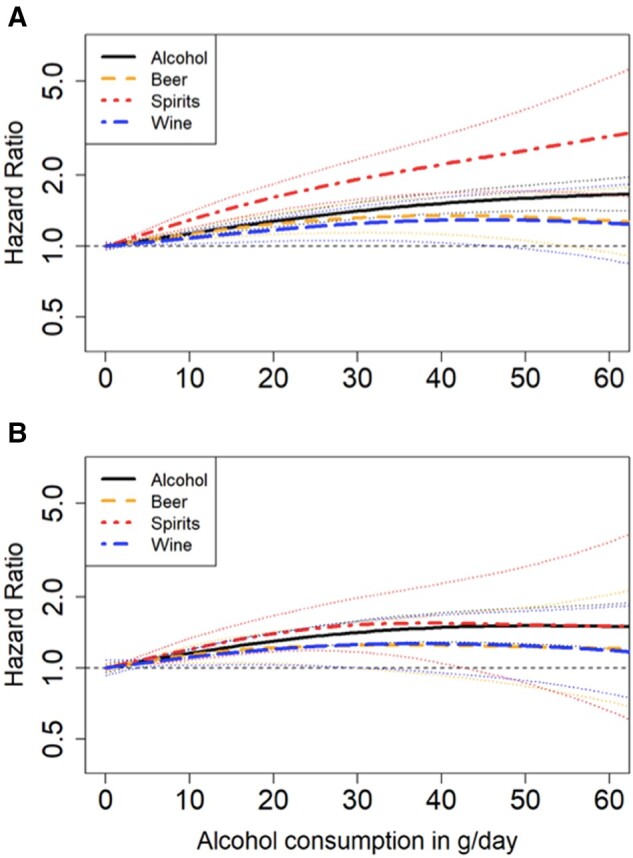This commentary refers to the article ‘Alcohol consumption, cardiac biomarkers, and risk of atrial fibrillation and adverse outcomes’, by D. Csengeri et al., doi: 10.1093/eurheartj/ehaa953 and the discussion piece ‘Alcohol and atrial fibrillation: not all drinks are created equal’, by F.H. Messerli and S. Dobner, doi:10.1093/eurheartj/ehab179.
We thank Drs Messerli and Dobner1 for highlighting an important controversy around alcohol and whether its dose-dependent relationship to atrial fibrillation (AF) risk is mitigated by the type alcoholic beverage consumed or the sociocultural context of consumption. Although light alcohol consumption may reduce the risk of other cardiovascular diseases,2 , 3 we observed an increase in AF incidence starting at very low levels of alcohol consumption across common types of alcoholic beverages (Figure 1A). Alcohol intake by self-report as in our study4 is prone to systematic error due to recall bias and underreporting. Although participants provided the proportion of alcohol consumed for each type of alcoholic beverages, the current analyses are not suited to fully disentangle the overlap of consumption of different types of alcohol. In addition, confounding by lifestyle and socioeconomic status are likely. Adjustment for education level and employment status in our study, however, revealed similar associations (Figure 1B).
Figure 1.

(A) Hazard ratio for incident atrial fibrillation for alcohol consumption in g/day by non-linear Cox regression plotted on the log-scale. The model (A) uses age as time scale and is sex- and cohort-stratified (data available for alcohol consumption in N = 92 452, for beer consumption in N = 61 296, for spirits consumption in N = 61 190 and for wine consumption in N = 61 233). The model (B) is sex- and cohort-stratified, using age as time scale, and adjusted for clinical risk factors, employment status, and education level (data available for alcohol consumption in N = 48 355, for beer, spirits, and wine consumption in N = 30 533). The reference value is 0 g/day.
In line with previous observations, our data showed that hazard ratios tended to be higher in beer and spirit drinkers than in wine drinkers, but the difference was not statistically significant despite the comparatively large number of outcomes. Our findings suggest that reducing alcohol consumption may be important for both prevention and management of AF independent of type of alcohol consumed. The causal pathways underlying this observation are probably manifold and need to be elucidated.
Conflict of interest: R.B.S. reports consulting and lecture fees from BMS/Pfizer outside the submitted work. The other authors report no conflicts of interest.
Contributor Information
Dora Csengeri, Department of Cardiology, University Heart & Vascular Center Hamburg, Eppendorf, Martinistraße 52, 20246 Hamburg, Germany.
Ngoc-Anh Sprünker, Department of Cardiology, University Heart & Vascular Center Hamburg, Eppendorf, Martinistraße 52, 20246 Hamburg, Germany.
Renate B Schnabel, Department of Cardiology, University Heart & Vascular Center Hamburg, Eppendorf, Martinistraße 52, 20246 Hamburg, Germany; German Center for Cardiovascular Research (DZHK), partner site, Luebeck/Hamburg/Kiel/, Potsdamer Straße 58, 10785 Berlin, Germany.
References
- 1. Messerli FH, Dobner S. Alcohol and atrial fibrillation: not all drinks are created equal. Eur Heart J 2021;42:2506. [DOI] [PubMed] [Google Scholar]
- 2. Bell S, Daskalopoulou M, Rapsomaniki E, George J, Britton A, Bobak M, Casas JP, Dale CE, Denaxas S, Shah AD, Hemingway H. Association between clinically recorded alcohol consumption and initial presentation of 12 cardiovascular diseases: population based cohort study using linked health records. BMJ 2017;356:j909. [DOI] [PMC free article] [PubMed] [Google Scholar]
- 3. Wood AM, Kaptoge S, Butterworth AS, Willeit P, Warnakula S, Bolton T, Paige E, Paul DS, Sweeting M, Burgess S, Bell S, Astle W, Stevens D, Koulman A, Selmer RM, Verschuren WMM, Sato S, Njølstad I, Woodward M, Salomaa V, Nordestgaard BG, Yeap BB, Fletcher A, Melander O, Kuller LH, Balkau B, Marmot M, Koenig W, Casiglia E, Cooper C, Arndt V, Franco OH, Wennberg P, Gallacher J, de la Cámara AG, Völzke H, Dahm CC, Dale CE, Bergmann MM, Crespo CJ, van der Schouw YT, Kaaks R, Simons LA, Lagiou P, Schoufour JD, Boer JMA, Key TJ, Rodriguez B, Moreno-Iribas C, Davidson KW, Taylor JO, Sacerdote C, Wallace RB, Quiros JR, Tumino R, Blazer DG, Linneberg A, Daimon M, Panico S, Howard B, Skeie G, Strandberg T, Weiderpass E, Nietert PJ, Psaty BM, Kromhout D, Salamanca-Fernandez E, Kiechl S, Krumholz HM, Grioni S, Palli D, Huerta JM, Price J, Sundström J, Arriola L, Arima H, Travis RC, Panagiotakos DB, Karakatsani A, Trichopoulou A, Kühn T, Grobbee DE, Barrett-Connor E, van Schoor N, Boeing H, Overvad K, Kauhanen J, Wareham N, Langenberg C, Forouhi N, Wennberg M, Després J-P, Cushman M, Cooper JA, Rodriguez CJ, Sakurai M, Shaw JE, Knuiman M, Voortman T, Meisinger C, Tjønneland A, Brenner H, Palmieri L, Dallongeville J, Brunner EJ, Assmann G, Trevisan M, Gillum RF, Ford I, Sattar N, Lazo M, Thompson SG, Ferrari P, Leon DA, Smith GD, Peto R, Jackson R, Banks E, Di Angelantonio E, Danesh J, Emerging Risk Factors Collaboration/EPIC-CVD/UK Biobank Alcohol Study Group. Risk thresholds for alcohol consumption: combined analysis of individual-participant data for 599 912 current drinkers in 83 prospective studies. Lancet 2018;391:1513–1523. [DOI] [PMC free article] [PubMed] [Google Scholar]
- 4. Csengeri D, Sprünker NA, Di Castelnuovo A, Niiranen T, Vishram-Nielsen JK, Costanzo S, Söderberg S, Jensen SM, Vartiainen E, Donati MB, Magnussen C, Camen S, Gianfagna F, Løchen ML, Kee F, Kontto J, Mathiesen EB, Koenig W Stefan B, de Gaetano G, Jørgensen T, Kuulasmaa K, Zeller T, Salomaa V, Iacoviello L, Schnabel RB. Alcohol consumption, cardiac biomarkers, and risk of atrial fibrillation and adverse outcomes. Eur Heart J 2021;doi: 10.1093/eurheartj/ehaa953. [DOI] [PMC free article] [PubMed] [Google Scholar]


